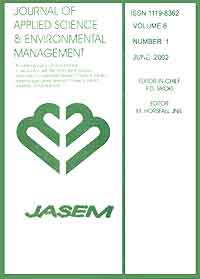
|
Journal of Applied Sciences and Environmental Management
World Bank assisted National Agricultural Research Project (NARP) - University of Port Harcourt
ISSN: 1119-8362
Vol. 9, No. 3, 2005, pp. 21-25
|
 Bioline Code: ja05053
Bioline Code: ja05053
Full paper language: English
Document type: Research Article
Document available free of charge
|
|
|
Journal of Applied Sciences and Environmental Management, Vol. 9, No. 3, 2005, pp. 21-25
| en |
Prevalence and distribution of ringworm infections in Primary School Children in parts of Eastern, Nigeria
ANOSIKE, J C; 1KEKE, I R; UWAEZUOKE, J C; ANOZIE, J C; OBIUKWU C E; NWOKE, B E B; AMAJUOYI, O U
Abstract
A study on the prevalence and distribution of ringworm infection amongst primary school children in northern EbonyiState
of eastern Nigeria was carried out between November 2002 and June 2003. Of the 279 pupils sampled randomly from four schools,
59 (21.1%) had ringworm infection. While only two genera of fungi Microsporum and Trichophyton were isolated, six species viz:
M. canis (11.9%), M. andoninii (20.3%), T. sondamense (20.3%), T. mentagrophytes (22.0%), T. schoenleinii
(15.3%) and T. quinckeannan
(10.2%) were also encountered. The distribution of ringworm among schools was not statistically significant (P > 0.05). Both male and
female pupils with in the age bracket of 5-7 years were significantly infected than other age categories (P<0.05). Infection decreased
with increase in age. Sex-related prevalence was not statistically significant (P>0.05). M. andoninii was more predominant over others in
males while T. mentagrophytes was more prevalent in female pupils. Poor infrastructures (houses and classroom), children playing with
animals, the Nigerian environmental vis-a-vis personal uncleaniness by pupils are contributing factors to the high frequency and severity
of ringworm in the area. @JASEM
|
| |
© Copyright 2005 - Journal of Applied Sciences & Environmental Management
|
|
